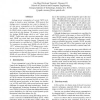37 search results - page 2 / 8 » Leakage Current Reduction in VLSI Systems |
DAC
2004
ACM
13 years 11 months ago
2004
ACM
The high leakage current in nano-meter regimes is becoming a significant portion of power dissipation in CMOS circuits as threshold voltage, channel length, and gate oxide thickne...
VLSI
2005
Springer
14 years 1 months ago
2005
Springer
Leakage power consumption of current CMOS technology is already a great challenge. ITRS projects that leakage power consumption may come to dominate total chip power consumption a...
DAC
2002
ACM
14 years 8 months ago
2002
ACM
Reducing power dissipation is one of the most principle subjects in VLSI design today. Scaling causes subthreshold leakage currents to become a large component of total power diss...
VLSID
2006
IEEE
14 years 8 months ago
2006
IEEE
For a nanoCMOS of sub-65nm technology, where the gate oxide (SiO2) thickness is very low, the gate leakage is one of the major components of power dissipation. In this paper, we pr...
DAC
2006
ACM
14 years 8 months ago
2006
ACM
Transistor leakage is poised to become the dominant source of power dissipation in digital systems, and reconfigurable devices are not immune to this problem. Modern FPGAs already...

